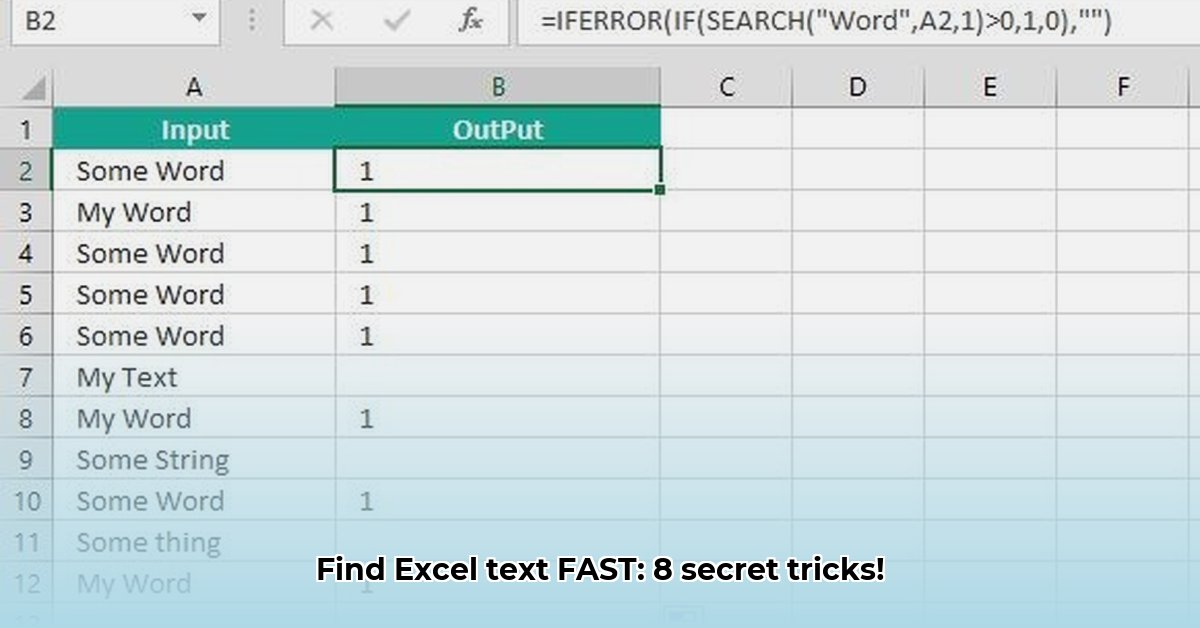
Finding specific text within your Excel spreadsheets can be time-consuming. This guide provides eight methods—from simple to advanced—to efficiently locate text, saving you hours of tedious work. We'll compare each technique, highlighting its strengths and weaknesses to help you select the best approach for your skill level and needs. This guide covers finding exact matches, partial matches, case-sensitive and case-insensitive searches, and counting occurrences. Mastering these methods will significantly improve your Excel proficiency.
Mastering Excel's Text-Matching Power: Eight Proven Methods
This section details eight methods for finding text in Excel, progressing from basic techniques suitable for beginners to more advanced functions for experienced users. Each method is illustrated with clear examples.
1. Simple "IF" Statement: The Beginner's Approach
This straightforward method is ideal for beginners seeking to determine if a cell contains an exact text string. It's case-sensitive, meaning "Sales Report" will not match "sales report".
- Formula:
=IF(A1="Sales Report", "Found!", "Not Found!") - Explanation: This formula checks if cell A1 exactly matches "Sales Report". If true, it returns "Found!"; otherwise, "Not Found!".
2. Exact Matching with "EXACT": Case-Sensitive Precision
For precise, case-sensitive matching, the EXACT function is indispensable. It will only return a match if the text, including capitalization, is identical.
- Formula:
=IF(EXACT(A1,"Sales Report"),"Found!","Not Found!") - Explanation: This formula ensures an exact match, considering case, between cell A1 and "Sales Report".
3. "FIND" and "ISNUMBER": Hunting for Substrings (Case-Sensitive)
The combination of FIND and ISNUMBER allows you to search for a substring within a cell. FIND locates the starting position of a text string; ISNUMBER confirms if a number (indicating a match) was returned. Note that this method is case-sensitive.
- Formula:
=IF(ISNUMBER(FIND("Report",A1)),"Found!","Not Found!") - Explanation: This finds "Report" within cell A1, even if it's part of a larger string like "Sales Report". It returns "Found!" if found, "Not Found!" otherwise.
4. Case-Insensitive Searching with "SEARCH": Flexible Matching
Similar to FIND, SEARCH searches for a substring, but it's case-insensitive. This makes it more versatile for situations where capitalization might vary.
- Formula:
=IF(ISNUMBER(SEARCH("report",A1)),"Found!","Not Found!") - Explanation: This finds "report," "Report," or "REPORT" within cell A1, regardless of case.
5. Counting Matches with "COUNTIF": Summarizing Occurrences
COUNTIF efficiently counts how many times a specific text string appears within a range of cells. This is particularly useful for summarizing data.
- Formula:
=COUNTIF(A1:A10,"Sales Report") - Explanation: Counts the number of cells from A1 to A10 containing "Sales Report".
6. Quick True/False with "SEARCH" and "ISNUMBER": Concise Results
For a simple yes/no answer regarding the presence of a text string, this concise formula is ideal. It returns TRUE if found, FALSE otherwise.
- Formula:
=ISNUMBER(SEARCH("report",A1)) - Explanation: Returns TRUE if "report" exists in A1 (case-insensitive), FALSE otherwise.
7. Advanced Counting with "SUMPRODUCT" and "COUNTIF": Multiple Criteria
SUMPRODUCT and COUNTIF can be combined to count occurrences of multiple text strings simultaneously.
- Formula:
=SUMPRODUCT(--(COUNTIF(A1:A10,{"Sales Report","Marketing Plan"})>0)) - Explanation: Counts cells in A1:A10 containing either "Sales Report" or "Marketing Plan".
8. VBA Macros: Automation for Experts (Advanced)
For advanced users, Visual Basic for Applications (VBA) macros offer powerful automation capabilities for complex text-matching tasks. While requiring programming skills, macros enable highly customized solutions for large datasets. This method is ideal for automating repetitive text manipulations.
Comparing Methods: A Practical Overview
The following table summarizes the advantages and disadvantages of each method, aiding in the selection of the most suitable approach for your specific needs.
| Method | Pros | Cons | Best Use Case |
|---|---|---|---|
Simple IF Statement | Simple, easy to understand | Case-sensitive, exact match only | Beginner-friendly, exact matches |
EXACT Function | Precise case-sensitive matching | Exact match only | Exact case-sensitive matching |
FIND & ISNUMBER | Finds substrings, case-sensitive | Slightly more complex | Finding parts of words, case-sensitive searches |
SEARCH & ISNUMBER | Finds substrings, case-insensitive | Slightly more complex | Finding parts of words, case-insensitive searches |
COUNTIF Function | Efficiently counts occurrences | Doesn't identify specific cells containing the text | Counting occurrences of a specific string |
ISNUMBER(SEARCH) | Quick TRUE/FALSE output | No details about location or occurrences | Quick check for text presence |
SUMPRODUCT/COUNTIF | Handles multiple criteria | More complex to implement | Counting with multiple conditions |
| VBA Macro | Highly customizable, automates complex tasks | Requires programming skills | Complex automation tasks, large datasets, heavy text manipulation |
Choosing the right method depends on your experience level and the complexity of your task. Experiment with different functions to discover the most efficient and accurate solutions for your specific data analysis needs. Remember to always consider the importance of case sensitivity when selecting your approach.